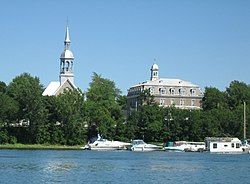Boucherville
| Boucherville | |||
|---|---|---|---|
| City | |||
 |
|||
|
|||
| Motto: Nature, patrimoine et art de vivre (French for "Nature, heritage and the art of life") |
|||
 Location within Urban Agglomeration of Longueuil. |
|||
| Location in southern Quebec. | |||
| Coordinates: 45°36′N 73°27′W / 45.600°N 73.450°WCoordinates: 45°36′N 73°27′W / 45.600°N 73.450°W | |||
| Country |
|
||
| Province |
|
||
| Region | Montérégie | ||
| RCM | None | ||
| Agglomeration | Longueuil | ||
| Settled | 1667 | ||
| Constituted | January 1, 2006 | ||
| Government | |||
| • Mayor | Jean Martel | ||
| • Federal riding | Longueuil—Saint-Hubert and Pierre-Boucher—Les Patriotes—Verchères | ||
| • Prov. riding | Montarville | ||
| Area | |||
| • Total | 81.10 km2 (31.31 sq mi) | ||
| • Land | 70.81 km2 (27.34 sq mi) | ||
| Population (2011) | |||
| • Total | 40,753 | ||
| • Density | 575.5/km2 (1,491/sq mi) | ||
| • Dwellings | 16,521 | ||
| Time zone | EST (UTC−5) | ||
| • Summer (DST) | EDT (UTC−4) | ||
| Postal code(s) | J4B | ||
| Area code(s) | 450 and 579 | ||
| Highways |
|
||
| Website | www |
||
Boucherville is a city in the Montérégie region in Quebec, Canada. It is a suburb of Montreal on the South shore of the Saint Lawrence River.
Boucherville is part of both the urban agglomeration of Longueuil and Montreal Metropolitan Community regional government.
Boucherville was founded as a seigneurial parish in 1667 by Pierre Boucher, for whom the city was later named. Pierre Boucher came from Mortagne-au-Perche, France. After having lived in Quebec City and Trois-Rivières, Boucher moved to the Percées Islands by the shores of Saint Lawrence River, where he founded Boucherville.
The first church of the village of Boucherville was built in 1670. This church, made of wood, was eventually replaced in 1712 by a building made of brick, which was in turn replaced by the current Sainte-Famille Church in 1801.
Several families left Boucherville in the 18th century to found the communities of Sainte-Julie and Saint-Bruno-de-Montarville.
In July 1843 fire destroyed much of the village. Sparks blowing from a steamer ignited a wooden building owned by Mr. Weilbrenner (lot 112). The fire spread and soon most of the village was on fire. In the end, the church, the chapel, two schools, 51 homes and pastures, and 92 other buildings were destroyed.
The village was progressively rebuilt. A new church was built on the site of the old one over the course of the following two years. Parts of the walls and front were reused. A stone school was built in 1851 at the intersection of Notre-Dame and Louis-Hyppolite-Lafontaine streets.
...
Wikipedia



